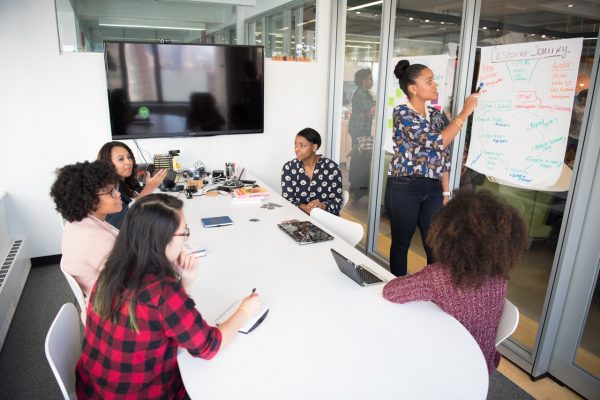It’s the hottest HR topic not directly related to tech. But to achieve true diversity and inclusion at work we must overcome pesky traits like unconscious bias, and to assure that reality, there is Natalie Mellin.
Natalie Mellin has gained experience from innovative tech companies like Spotify and King, and has played a central role in creating workplace awareness around diversity and inclusion over the last decade. She is one of the pioneers who helped reshape the conversation, and behavioral science inspires everything she does. With cross-functional research, she creates practical tools like process nudges and strategies to help both individuals and organizations make an impact.
With her vast experience from working both in-house and as well as consultancy, she is known as an influencer, dynamic speaker and we are honored to welcome her to Hiring Success 18 Europe in Berlin, September 19-21.
What does hiring success mean to you?
We need to change our hiring structures and processes to make better hires, which in the end, creates better and more sustainable business success. For me, this means identifying where you have the most bias in your process, redesign the steps to mitigate this, and cultivate diversity and inclusion.

How have attitudes towards diversity and inclusion changed over the last while?
Despite years of diversity training and anti-discrimination policies, one could argue we’ve not come very far. In fact, the World Economic Forum reports that the gender gap is widening in their 2017 report. McKinsey’s also reports in their 2017 Women in the Workplace study, that women represent only 18 percent of all c-suite roles. That number compares to 12 percent for men of color and only 3 percent for women of color. This is despite the fact that McKinsey’s 2018 report, ‘Delivering through Diversity’ reinforced the link between diversity and positive company financial performance.
Our brain gets hit by 11 million signals at any given moment in time. But we can only consciously process 40 of those. This means a tremendous amount of signals get processed using prior knowledge and patterns. This is unconscious bias. We need to focus on nudging our unconscious minds to mitigate more of the racist, sexist, and such behavior, and I believe we can do that through behavioral economics. Another way of saying it, my view has changed in the terms that I no longer believe we can train away our bias. We need to design it away.
What do you tell companies the biggest advantage of diversion and inclusivity are?
Besides the fact that it’s the right thing to do, it makes business sense.
- Driving business success and profits – a McKinsey report on public companies found that those in the top quartile for ethnic and racial diversity in management were 33 percent more likely to have financial returns above their industry mean, and those in the top quartile for gender diversity were 21 percent more likely to have returns above the industry mean.
- Drive innovation – Leaders who give diverse voices equal airtime are nearly twice as likely as others to unleash value-driving insights, and employees in a ‘speak up’ culture are 3.5 times as likely to contribute their full innovative potential. HBR
- Understanding our consumers and essentially making us smarter – In recent years a body of research has revealed another, more nuanced benefit of workplace diversity: non-homogenous teams are simply smarter. Working with people who are different than you challenges your brain to overcome its stale ways of thinking, which sharpens performance.
What kind of resistance do you get from organizations, and what do you do to get on board?
Nowadays it’s mostly about ‘how’. Something I completely understand, but we have years and years of research showing that diversity is correlated with both profitability and added value. Even so, for some companies or some executives, even the most compelling data seems to require additional rounds of convincing. Probably shouldn’t surprise me either. after all, research has proven facts and data don’t actually change people’s minds. But I found this quote the other day and thought it was quite good.
‘The house burned in front of them but they wanted the data to prove it. That is the audacity and ridiculousness of making the business case: convincing one of the obvious. If the smoke doesn’t alarm you, the fire certainly should.’ – Bernard Coleman III
What are behavioral economics?
I will again borrow the words of a much wiser person; “…the best way to think about behavioral economics is in contrast to standard economics. In standard economics, we think — we assume — that people are perfectly rational, which means that they always behave in the best way for them. They can compute everything, they can calculate everything and they can make, always, consistently, the right decisions. In contrast, behavioral economics doesn’t assume much about people. Instead of starting from the idea that people are perfectly rational, we say we just don’t know, but let’s check it out. So, what we do is we put people in different situations to check how they actually make decisions. And what we find in those experiments is that people often don’t behave as you would expect from a perfectly rational perspective. So, in essence, it’s an empirical and non-idealistic way to start looking at human behavior. And because we find that people behave differently than expected, often irrationally, it also leads often to different conclusions about how companies should be created, what the government should do, and, of course, what individuals should be doing.” – Dan Ariely
Was there a eureka moment that made you want to address diversity and inclusion full-time? How did that happen?
Well, my mom tells me that I was questioning gender equality as a young kid. Then I took gender studies at university. This was an eye-opener in many ways. I found out about intersectionality, that we are more than one thing and that the power structure today will hand me a completely different experience as a white, middle-class woman compared to a woman of color from a lower socio-economic background. After being inspired by behavioral economics, I got angrier that we weren’t making enough progress in the space of diversity & inclusion in companies. And I thought everyone was tackling it wrong. I couldn’t understand why no one was using cross-functional research to make progress faster. So I started to get involved. First, it was a project, then it was 10-20 percent of my job, until it took over all of the time I spent at work.
What is one thing even well-intentioned organizations get wrong about diversity and inclusion?
Many companies believe it’s too hard a problem to solve, or they focus too much on how to ‘speak’ to our conscious minds when trying to create change. I hope that more companies will learn from behavioral economics and embed D&I philosophy into the business strategy. It works best when a CEO truly thinks about D&I as a strategy for business success.
What about starting your own firm, how did that come about, and what can you do differently on your own that you could have with your previous employers?
It grew primarily organically. I started getting requests a few years ago, but sadly didn’t always have the ability to help while working in-house full time. This spring I decided that I needed a new challenge, and in the near future, I want to develop a free tool to help companies who may not have the funds to drive change. It’s a very exciting time. I get requests right and left. This is key as we will never succeed here as one, we need to create community and drive change on a bigger scale. That’s what I hope to do with my company.






